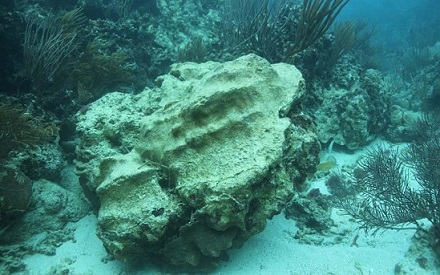- ABOUT US
- PROGRAM AREAS
- CONSERVATION APPROACH
- EDUCATION
- MULTIMEDIA
Looking Out for Hurricanes and Corals
It may seem early, but hurricane season is right around the corner. Hurricane season begins on May 15 in the eastern Pacific Ocean, and on June 1 in the central Pacific and Atlantic Oceans. Hurricanes have become more frequent and stronger, impacting coastal communities and economies. The five costliest U.S. hurricanes of record occurred in the last 15 years, with three occurring in 2017 alone. Yet communities and organizations are recognizing the benefits of natural coastal ecosystems, such as coral reefs, in decreasing the effects of storms.

Healthy coral reefs can absorb up to 97 percent of a wave’s energy, buffering coastal communities from storms and associated waves, flooding, and erosion. In fact, the U.S. is among the top 10 nations that receives decreased natural disaster risks from coral reefs. A U.S. Geological Survey study determined that coral reefs protect more than 18,000 Americans, over $825 million in coastal infrastructure, and nearly $700 million in economic activity from storm-related flooding every year.
NOAA and the coral reef community are taking new steps in recognition of these services. The Federal Emergency Management Agency (FEMA) recently joined the U.S. Coral Reef Task Force, which leads U.S. efforts to preserve and protect coral reef ecosystems. This will allow FEMA to regularly work with other federal agencies and local governments in preparation for and in response to hurricanes and other disasters.

For the first time, the Coral Reef Conservation Program is supporting FEMA’s ongoing recovery and restoration efforts in Puerto Rico as a result of Hurricane Maria. This partnership highlights the importance of coral reefs as natural structures that provide protection, and could serve as an example for future storm recovery activities.
Humans will continue to make their lives on the coast, and hurricanes will continue to put those lives and economies at risk. Coral reefs are one of the natural ecosystems that we can preserve both for the health of the ocean and for our safety.
About Us

The NOAA Coral Reef Conservation Program was established in 2000 by the Coral Reef Conservation Act. Headquartered in Silver Spring, Maryland, the program is part of NOAA's Office for Coastal Management.

The Coral Reef Information System (CoRIS) is the program's information portal that provides access to NOAA coral reef data and products.
Work With US
U.S. Coral Reef Task Force
Funding Opportunities
Employment
Fellowship Program
Contracting Assistance
Graphic Identifier
Featured Stories Archive

Access the archive of featured stories here...
Feedback
Thank you for visiting NOAA’s Coral Reef Conservation Program online. Please take our website satisfaction survey. We welcome your ideas, comments, and feedback. Questions? Email coralreef@noaa.gov.
Stay Connected
Contact Us
NOAA’s Coral Reef Conservation Program
SSMC4, 10th Floor
1305 East West Highway
Silver Spring, MD 20910
coralreef@noaa.gov
